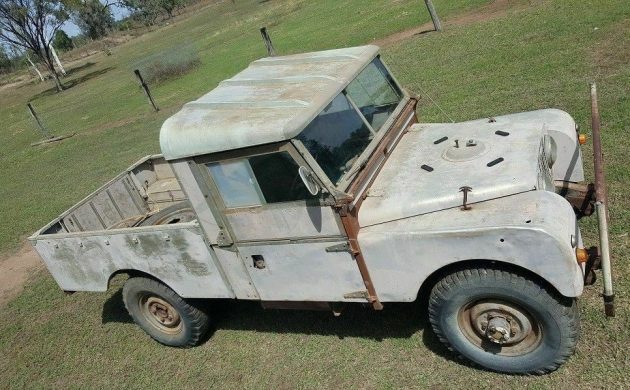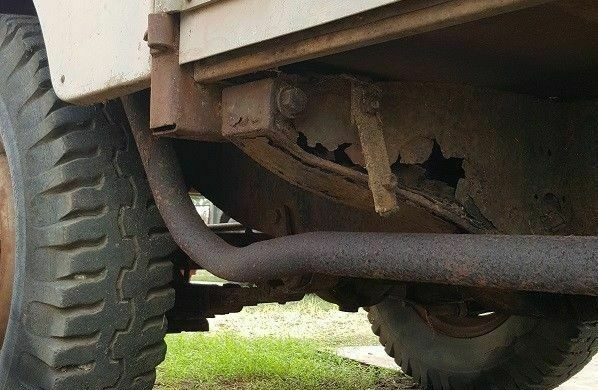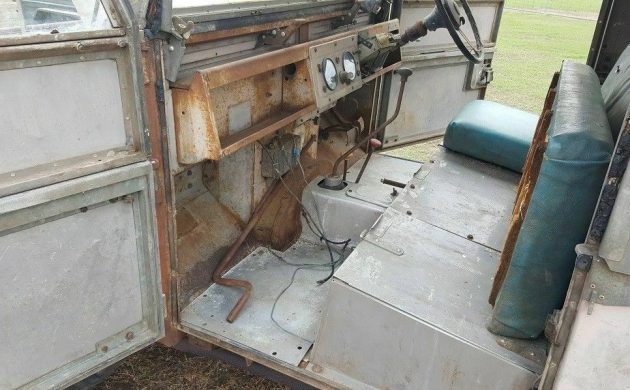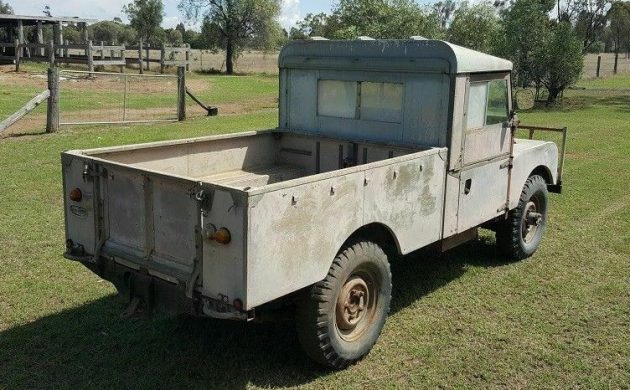A quick quiz question for you: What distinctive feature did the original Land Rover prototype share with the McLaren F1 Supercar? If you don’t know the answer, then please continue reading, as all will be revealed. Unveiled to the world at the 1948 Amsterdam Motor Show, the Land Rover Series I remained in production until 1958. During this time the vehicle underwent a number of running changes in a bid to improve both performance and reliability. Speaking of bidding, you will find this 1955 Series I listed for sale here on eBay. However, you won’t need to bid, as the owner has set a BIN price of $12,500, but the option is there to make an offer. If you want to perform a personal inspection, then the Land Rover is located in Round Rock, Texas.
The aluminum alloy body of a Land Rover doesn’t present any real issues with rust, although some can experience a type of electrolysis where the alloy body touches the steel frame. The frame is an area that can be prone to some rust issues, and the spot that you can see in this photo seems to be the worst of it. The owner is going to supply a replacement part for this rusty outrigger, so that’s a start. There is also a small amount of rust in the front of the frame, but once again, this should be a fairly easy repair. The rest of the frame has a coating of surface corrosion but does appear to be solid. In 1954, Land Rover introduced the Pickup, which was built on a 107″ wheelbase, as opposed to the standard vehicle’s 86″ version. All of that extra length was exclusively for the bed, with both models being identical from the doors forward. This provided some quite handy load space, although due to low horsepower levels, a fully laden Series I is not a fast vehicle.
So, let’s talk about interior trim. Actually, that doesn’t give us a lot to talk about. You get padding and vinyl on the seats, and everything else is painted metal. The Land Rover was conceived as an agricultural and commercial vehicle. The manufacturer reasoned that luxuries such as carpet weren’t really compatible with farm mud and other icky stuff, so the best that you could hope for was a rubber mat, which this one doesn’t have. Having said that, the interior is complete, and apart from the radio hanging off the dash, it also seems to be largely original. It looks like it would be a fairly straightforward restoration prospect. The other thing to consider is the fact that the Land Rover is right-hand drive. Up until 2018, the vehicle called Australia home, which explains this. It could be converted to left-hand drive without a lot of trouble, but that would destroy the vehicle’s originality, so I’d be inclined to leave it as it is.
The owner claims that the Land Rover has only covered a genuine 37,000 miles and that it has spent its entire life on a farm or ranch in Australia. That makes the claim conceivable, as it wasn’t unusual for these to be purchased exclusively for farm use, and there are still a few around that have never actually been on the open road. Under the hood is a 2.0-liter 4-cylinder petrol engine, while the transmission is a 4-speed manual. The owner says that the vehicle starts, runs, and stops, but doesn’t give us a lot of information beyond that. One of the reasons why Australia tends to be a pretty decent location to source a Land Rover revolves around market success. At its peak, the Land Rover actually commanded a staggering 90% of all new 4-wheel drive vehicles sold Down Under. That made them a common sight on Australian roads until the Toyota Land Cruiser hit the market. In a few short years, Land Rover’s share plummeted from those lofty heights to the point where their market share was reduced to 2%. That also means that there is an unknown number of these old beasts hiding away in farm sheds and barns, just waiting to be revived.
Okay, back to our pop quiz. Have you worked out what feature was shared between the original Land Rover prototype and the McLaren F1? The answer is that both shared a central driving position. The Land Rover prototypes placed the driver in the center of the car, with his legs straddling the transmission tunnel. Producing vehicles in this configuration proved to be fraught with problems, so this changed fairly quickly. Finding a right-hand drive Land Rover Series I Pickup in the USA is not terribly easy, so this is a car that would be suited to someone looking for something a bit unusual in a classic off-roader.






The driver in the center !!
A rather nice idea, a totally enclosed motorcycle, hmmmmmmmmmmmmm.
And this enclosed motorcycle can haul freight too, that’s a bonus.
Would the gear shift be between the drivers legs? or would it hang from the ceiling?
No problem a pretty girl on each side. All kinds of fun.
It might be a great concept if it does not have Armstrong steering, but I think it just might.
Land Rover Series 1s& 2’s are one of the only vehicles that actually gain value when the frame is replaced. Early British steel wasn’t great, combined with challenge from electrolysis. I would be skeptical of the integrity of this frame. Calls for a rigorous inspection on a lift.
I would replace the frame with a galvanized unit. And there is always a problem with the conversion from right to left and vice versa. People convert Aston Martins, Jaguars, pretty much everything from U.K manufacturers, and from what I have noticed,is that it really doesn’t hurt the value at all. The desire for a certain make and model is what will drive the market price. I say if you want left hand drive then do it. It’s far easier to sell a left hand drive car than a right. Just my two cents worth.
You know, a “Landie” is one 4×4 I haven’t seen here in Colorado. Just about every other kind, including a Nissan Patrol ( not running) and about 40 million FJ’s, I swear, they all came out there, but never a Land Rover. No ’56 Pontiac 4×4’s either.Kind of odd, one of the best 4×4’s never made it here. I couldn’t drive a RHD vehicle, but would love a Landie. Show them FJ dudes a thing or two.
Howard there should still be a few Land Rovers out there, they had a dealer for them in Grand Junction back in the sixties. My parents bought a new 1964 Land Rover 88 soft top back in the summer of 64 when I was a kid. We traded it in 66 for a 65 Land Rover hardtop model with a Belgrade 600 Lb. winch. Both were OK vehicles but lacking in power and were not as tough as they were made out to be. The advantage of the aluminum body and the galvanized frame and bumpers was kind of nice. In the early 70’s I purchased a new 1974 FJ40 and kept it until the body and frame rusted away. The FJ had way more power, drove better, and I honestly believe it was built stronger than the Rover. To each his own but after driving and owning both I think the FJ is the tougher of the two. They were both a lot of fun and neither left us stranded but the Rover broke several axles and springs. I would never pay the price people are asking for one of these. I think the newer model Defenders are a much better looking rig but over priced.
Bought my 109 Landie in Denver. Coolest truck I ever owned.
Did you know the first prototype Land Rover with the central steering was built on a War time Willys Jeep chassis, using a 1600cc Rover engine mated to the jeep gear/transfer box and using jeep axles